Mars Aka. Red Rock And A Bunch Of Pivot Irrigation Crop Circles

Mars aka. Red Rock and a bunch of Pivot Irrigation crop circles
More Posts from Maevetheeuropan and Others
Solar System: Things to Know This Week
Almost every day, we receive a message from a spacecraft more than 10.6 billion miles (about 17 billion km) away.
At that unimaginable distance, it takes the radio signal almost 16 hours to arrive. The spacecraft is Voyager 2, which launched 40 years ago this month. It’s still operating, sending back dispatches from the dark reaches well beyond the orbit of Pluto. Even now, scientists are still actively exploring the outer boundaries of the solar system using Voyager 2, decades after its “Grand Tour” of the giant planets Jupiter, Saturn, Uranus and Neptune revealed their splendors like never before. This week, we recall 10 highlights from one of the most epic voyages in human history.
1. A Journey of 10 Billion Miles Begins With the First Step

Voyager 2 set out from Earth on Aug. 20, 1977. Even though it launched before its twin spacecraft, Voyager 1, it carried the ‘2’ moniker because mission planners knew its trajectory would bring it to Jupiter after Voyager 1’s arrival there.
2. The Grand Tour
Voyager 2’s trajectory was special because it took advantage of a rare orbital alignment to fly by all four gas giant planets: Jupiter, Saturn, Uranus and Neptune. It was the first, and so far the only, spacecraft to carry out a close-up reconnaissance of Uranus and Neptune.
3. Not-So-Gentle Giant
Voyager 2 flew by Jupiter in April 1979, capturing striking images of the planet’s volcanic moon Io and its violent storms larger than the entire Earth.
4. Saturn’s Not the Only One

Jupiter has its own ring system, and Voyager 2 provided the first pictures.
5. An Ocean Under Ice
During its Jupiter encounter, Voyager 2 obtained close-up looks at Jupiter’s moon Europa, including linear cracks and other features which first led scientists to realize Europa probably hides a vast sea of liquid water beneath an icy shell, the first known world outside Earth that could have an ocean.
6. Ringworld, the Prequel
Voyager 2 zoomed through the Saturn system in August 1981. It saw hints of mysterious features that the Cassini mission would later reveal in stunning detail, including Enceladus, with its bright surface that suggested geologic activity, and Saturn’s intriguing hexagonal jet stream.
7. Swiftly by a Tilted Planet
In January 1984, Voyager offered humanity its first detailed look at the seventh planet, Uranus, the only one tilted on its side relative to the Sun. Voyager images revealed 11 new moons, including Juliet, Puck, Cressida, Rosalind and Ophelia. The moon Miranda presented a bizarre landscape that left scientists debating its origins for years. Voyager also captured views of the planet’s lacy rings, and found that it is the coldest in the solar system, at minus 353 degrees Fahrenheit (59 Kelvin).
8. In Neptune’s Blue Realm

After picking up a gravitational speed boost at each previous planetary encounter, by the time Voyager reached Neptune it shot through the entire system of Neptunian rings and moons in a matter of hours. Voyager saw a titanic storm in Neptune’s windy atmosphere, discovered new moons, and revealed active geysers erupting on Triton’s frigid surface.
9. Postcards From the Edge
Although their cameras are no longer functioning, other key scientific instruments on board both Voyager spacecraft are still collecting data. Voyager 1 is exploring the boundary between the Sun’s realm and interstellar space. Voyager 2 hasn’t traveled quite as far. In September 2007, it crossed the termination shock (where the speed of the solar wind of charged particles drops below the speed of sound) at a point about 84 Astronomical Units from the Sun (more than twice the distance to Pluto). See https://go.nasa.gov/2uwrndb
10. Ride Along
Voyager’s mission is far from over. Engineers estimate the spacecraft will have enough power to operate into the mid-2020s. You can ride along at www.jpl.nasa.gov/voyager, or by following @NASAVoyager on Twitter and by downloading our free 3-D space simulation software, Eyes on the Solar System at eyes.nasa.gov.

One more thing: Inspired by the messages of goodwill carried on Voyager’s Golden Record, you’re invited to send a short, uplifting message to Voyager and all that lies beyond it via social media. With input from the Voyager team and a public vote, one of these messages will be selected for us to beam into interstellar space on Sept. 5, 2017—the 40th anniversary of Voyager 1’s launch. Post your message on social media with the tag #MessageToVoyager by Aug 15. Details: www.jpl.nasa.gov/voyager/message/
Make sure to follow us on Tumblr for your regular dose of space: http://nasa.tumblr.com
When Dead Stars Collide!
Gravity has been making waves - literally. Earlier this month, the Nobel Prize in Physics was awarded for the first direct detection of gravitational waves two years ago. But astronomers just announced another huge advance in the field of gravitational waves - for the first time, we’ve observed light and gravitational waves from the same source.

There was a pair of orbiting neutron stars in a galaxy (called NGC 4993). Neutron stars are the crushed leftover cores of massive stars (stars more than 8 times the mass of our sun) that long ago exploded as supernovas. There are many such pairs of binaries in this galaxy, and in all the galaxies we can see, but something special was about to happen to this particular pair.

Each time these neutron stars orbited, they would lose a teeny bit of gravitational energy to gravitational waves. Gravitational waves are disturbances in space-time - the very fabric of the universe - that travel at the speed of light. The waves are emitted by any mass that is changing speed or direction, like this pair of orbiting neutron stars. However, the gravitational waves are very faint unless the neutron stars are very close and orbiting around each other very fast.

As luck would have it, the teeny energy loss caused the two neutron stars to get a teeny bit closer to each other and orbit a teeny bit faster. After hundreds of millions of years, all those teeny bits added up, and the neutron stars were *very* close. So close that … BOOM! … they collided. And we witnessed it on Earth on August 17, 2017.

Credit: National Science Foundation/LIGO/Sonoma State University/A. Simonnet
A couple of very cool things happened in that collision - and we expect they happen in all such neutron star collisions. Just before the neutron stars collided, the gravitational waves were strong enough and at just the right frequency that the National Science Foundation (NSF)’s Laser Interferometer Gravitational-Wave Observatory (LIGO) and European Gravitational Observatory’s Virgo could detect them. Just after the collision, those waves quickly faded out because there are no longer two things orbiting around each other!
LIGO is a ground-based detector waiting for gravitational waves to pass through its facilities on Earth. When it is active, it can detect them from almost anywhere in space.

The other thing that happened was what we call a gamma-ray burst. When they get very close, the neutron stars break apart and create a spectacular, but short, explosion. For a couple of seconds, our Fermi Gamma-ray Telescope saw gamma-rays from that explosion. Fermi’s Gamma-ray Burst Monitor is one of our eyes on the sky, looking out for such bursts of gamma-rays that scientists want to catch as soon as they’re happening.
And those gamma-rays came just 1.7 seconds after the gravitational wave signal. The galaxy this occurred in is 130 million light-years away, so the light and gravitational waves were traveling for 130 million years before we detected them.

After that initial burst of gamma-rays, the debris from the explosion continued to glow, fading as it expanded outward. Our Swift, Hubble, Chandra and Spitzer telescopes, along with a number of ground-based observers, were poised to look at this afterglow from the explosion in ultraviolet, optical, X-ray and infrared light. Such coordination between satellites is something that we’ve been doing with our international partners for decades, so we catch events like this one as quickly as possible and in as many wavelengths as possible.

Astronomers have thought that neutron star mergers were the cause of one type of gamma-ray burst - a short gamma-ray burst, like the one they observed on August 17. It wasn’t until we could combine the data from our satellites with the information from LIGO/Virgo that we could confirm this directly.

This event begins a new chapter in astronomy. For centuries, light was the only way we could learn about our universe. Now, we’ve opened up a whole new window into the study of neutron stars and black holes. This means we can see things we could not detect before.

The first LIGO detection was of a pair of merging black holes. Mergers like that may be happening as often as once a month across the universe, but they do not produce much light because there’s little to nothing left around the black hole to emit light. In that case, gravitational waves were the only way to detect the merger.

Image Credit: LIGO/Caltech/MIT/Sonoma State (Aurore Simonnet)
The neutron star merger, though, has plenty of material to emit light. By combining different kinds of light with gravitational waves, we are learning how matter behaves in the most extreme environments. We are learning more about how the gravitational wave information fits with what we already know from light - and in the process we’re solving some long-standing mysteries!
Want to know more? Get more information HERE.
Make sure to follow us on Tumblr for your regular dose of space: http://nasa.tumblr.com

Living and Working Aboard Station
Join us on Facebook Live for a conversation with astronaut Kate Rubins and the director of the National Institutes for Health on Tuesday, October 18 at 11:15 a.m. ET.
Astronaut Kate Rubins has conducted out of this world research aboard Earth’s only orbiting laboratory. During her time aboard the International Space Station, she became the first person to sequence DNA in space. On Tuesday, she’ll be live on Facebook with National Institute of Health director Francis Collins, who led the effort to map the human genome. You can submit questions for Kate using the hashtag #SpaceChat on Twitter, or during the live event. Here’s a primer on the science this PhD astronaut has been conducting to help inspire your questions:

Kate has a background in genomics (a branch of molecular genetics that deals with the study of genomes,specifically the identification and sequencing of their constituent genes and the application of this knowledge in medicine, pharmacy,agriculture, and other fields). When she began her tenure on the station, zero base pairs of DNA had been sequenced in space. Within just a few weeks, she and the Biomolecule Sequencer team had sequenced their one billionth base of DNA aboard the orbital platform.
“I [have a] genomics background, [so] I get really excited about that kind of stuff,” Rubins said in a downlink shortly after reaching the one billion base pairs sequenced goal.
Learn more about this achievement:
+First DNA Sequencing in Space a Game Changer
+Science in Short: One Billion Base Pairs Sequenced
Why is DNA Sequencing in Space a Big Deal?
A space-based DNA sequencer could identify microbes, diagnose diseases and understand crew member health, and potentially help detect DNA-based life elsewhere in the solar system.
+Why Sequencing DNA in Space is a Big Deal
https://youtu.be/1N0qm8HcFRI
Miss the Reddit AMA on the subject? Here’s a transcript:
+NASA AMA: We just sequenced DNA in space for the first time. Ask us anything!
NASA and Its Partnerships

We’re not doing this alone. Just like the DNA sequencing was a collaborative project with industry, so is the Eli Lilly Hard to Wet Surfaces investigation. In this experiment aboard the station, astronauts will study how certain materials used in the pharmaceutical industry dissolve in water while in microgravity. Results from this investigation could help improve the design of tablets that dissolve in the body to deliver drugs, thereby improving drug design for medicines used in space and on Earth. Learn more about what we and our partners are doing:
+Eli Lilly Hard to Wet Surfaces – been happening the last week and a half or so
Researchers to Test How Solids Dissolve in Space to Design Better Tablets and Pills on Earth
With our colleagues at the Stanford University School of Medicine, we’re also investigating the effects of spaceflight on stem cell-derived heart cells, specifically how heart muscle tissue, contracts, grows and changes in microgravity and how those changes vary between subjects. Understanding how heart muscle cells change in space improves efforts for studying disease, screening drugs and conducting cell replacement therapy for future space missions. Learn more:
+Heart Cells
+Weekly Recap From the Expedition Lead Scientist for Aug. 18, 2016
It’s Not Just Medicine

Kate and her crew mates have also worked on the combustion experiments.
Kate has also worked on the Bigelow Expandable Activity Module (BEAM), an experimental expandable capsule that docks with the station. As we work on our Journey to Mars, future space habitats are a necessity. BEAM, designed for Mars or other destinations, is a lightweight and relatively simple to construct solution. Kate has recently examined BEAM, currently attached to the station, to take measurements and install sensors.

Kate recently performed a harvest of the Plant RNA Regulation experiment, by removing seed cassettes and stowing them in cold stowage.

The Plant RNA Regulation investigation studies the first steps of gene expression involved in development of roots and shoots. Scientists expect to find new molecules that play a role in how plants adapt and respond to the microgravity environment of space, which provides new insight into growing plants for food and oxygen supplies on long-duration missions. Read more about the experiment:
+Plant RNA Harvest
NASA Astronaut Kate Rubins is participating in several investigations examining changes in her body as a result of living in space. Some of these changes are similar to issues experienced by our elderly on Earth; for example, bone loss (osteoporosis), cardiovascular deconditioning, immune dysfunction, and muscle atrophy. Understanding these changes and how to prevent them in astronauts off the Earth may help improve health for all of us on the Earth. In additional, the crew aboard station is also working on more generalized studies of aging.
+ Study of the effects of aging on C. elegans, a model organism for a range of biological studies.

Fantastic success story for the astronomy community of China, congratulations!
Solar System: Things to Know This Week
Learn about the science of photonics to create space communications, get updates on Juno, mining data from Voyager for new discoveries and more.

1. Carried on a Beam of Light
One of our major priorities is to make space communications more efficient. While our communications systems have matured over the decades, they still use the same radio-frequency system developed in the earliest days of the agency. After more than 50 years, we’re investing in new ways to increase data rates while also finding more efficient communications systems. Photonics–generating, detecting and manipulating particles of light–may provide the solution.
+ See how it works

2. It’s No Joke: Two New Moons for the Seventh Planet
Voyager 2 spacecraft flew by Uranus 30 years ago, but researchers are still making discoveries using the data it gathered. A new study led by University of Idaho researchers suggests there could be two tiny, previously undiscovered moonlets orbiting near two of the planet’s rings.
+ Find out how they were discovered

3. Vortex of Mystery
As southern winter solstice approaches in the Saturn system, our Cassini spacecraft has revealed dramatic seasonal changes in the atmospheric temperature and composition of Saturn’s largest moon, Titan. Winter is taking a grip on Titan’s southern hemisphere, and a strong, whirling vortex has intensified in the upper atmosphere over the south pole.
+See more

4. The Spiders of Mars
Ten thousand volunteers viewing images of Martian south polar regions have helped identify targets for closer inspection, yielding new insights about seasonal slabs of frozen carbon dioxide and erosional features known as “spiders.” From the comfort of home, the volunteers have been exploring the surface of Mars by reviewing images from the Context Camera on our Mars Reconnaissance Orbiter and identifying certain types of seasonal terrains near Mars’ south pole.
+ Learn more and see how you can join in

7. Better Safe than Sorry
Juno entered safe mode last week and early indications are a software performance monitor induced a reboot of the spacecraft’s onboard computer. In this case, the safe mode turned off instruments and a few non-critical spacecraft components, and it confirmed the spacecraft was pointed toward the sun to ensure the solar arrays received power.The spacecraft acted as expected during the transition into safe mode, restarted successfully and is healthy. High-rate data has been restored, and the spacecraft is conducting flight software diagnostics. Meanwhile, the Juno science team continues to analyze returns from the first close Jupiter flyby on Aug. 27. Revelations so far include that Jupiter’s magnetic fields and aurora are bigger and more powerful than thought. Scientists have also had their first glimpse below the planet’s swirling cloud deck. The next close flyby is scheduled on Dec. 11, with all science instruments on.
+ Get the details
Discover the full list of 10 things to know about our solar system this week HERE.
Make sure to follow us on Tumblr for your regular dose of space: http://nasa.tumblr.com

Glittering Frisbee Galaxy: This image from Hubble’s shows a section of a spiral galaxy located about 50 million light-years from Earth. We tend to think of spiral galaxies as massive and roughly circular celestial bodies, so this glittering oval does not immediately appear to fit the visual bill. What’s going on? Imagine a spiral galaxy as a circular frisbee spinning gently in space. When we see it face on, our observations reveal a spectacular amount of detail and structure. However, the galaxy frisbee is very nearly edge-on with respect to Earth, giving it an appearance that is more oval than circular. The spiral arms, which curve out from the galaxy’s dense core, can just about be seen. Although spiral galaxies might appear static with their picturesque shapes frozen in space, this is very far from the truth. The stars in these dramatic spiral configurations are constantly moving as they orbit around the galaxy’s core, with those on the inside making the orbit faster than those sitting further out. This makes the formation and continued existence of a spiral galaxy’s arms something of a cosmic puzzle, because the arms wrapped around the spinning core should become wound tighter and tighter as time goes on - but this is not what we see. This is known as the winding problem. Image credit: ESA/Hubble & NASA For more information on this image, visit: https://go.nasa.gov/2niODGL
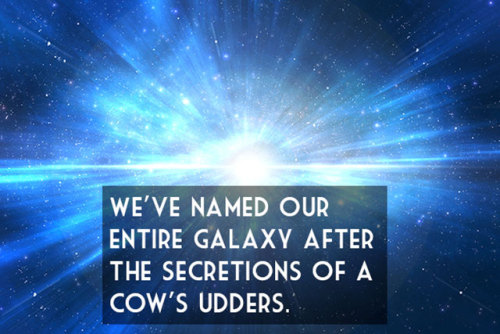
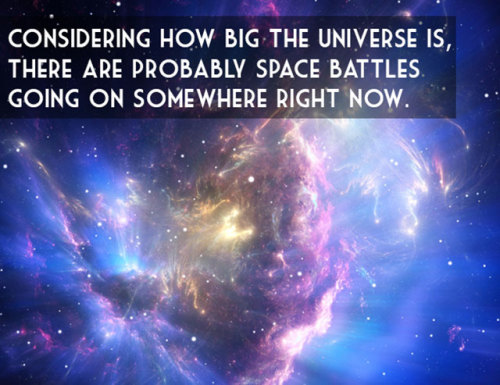
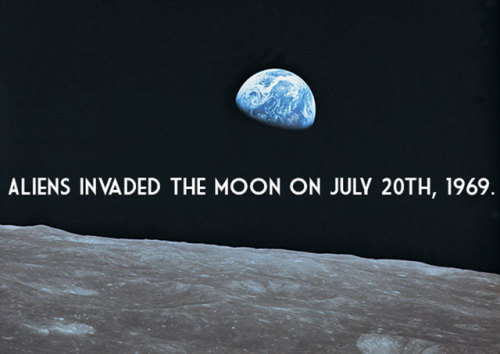
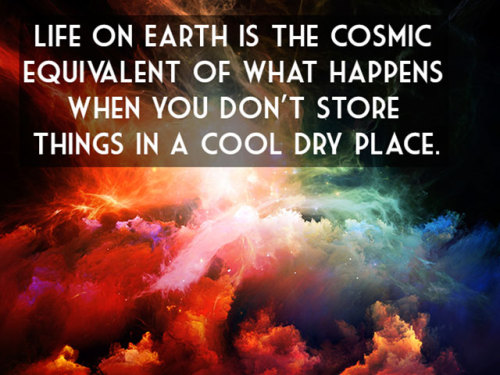
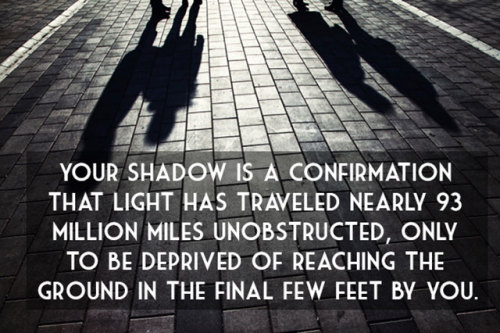
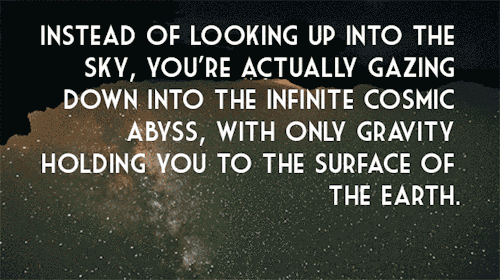
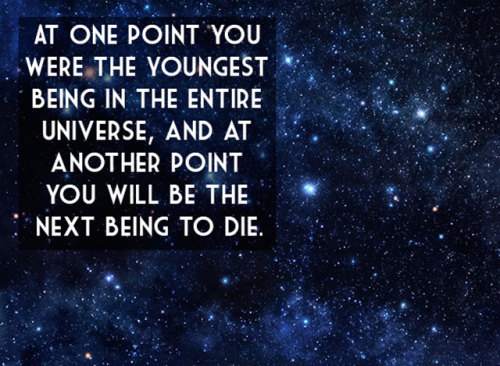
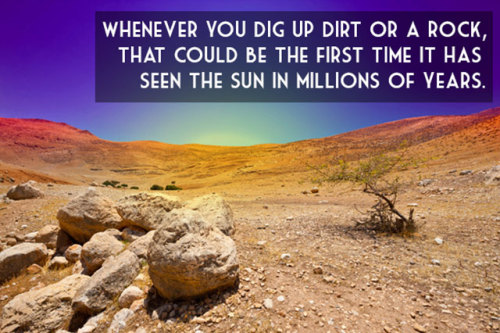
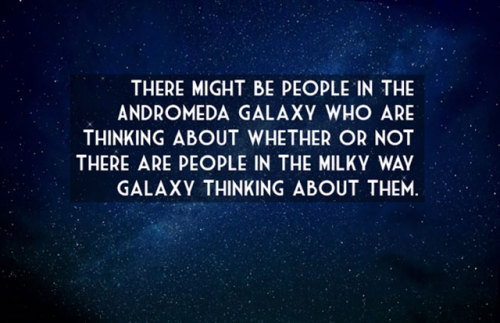
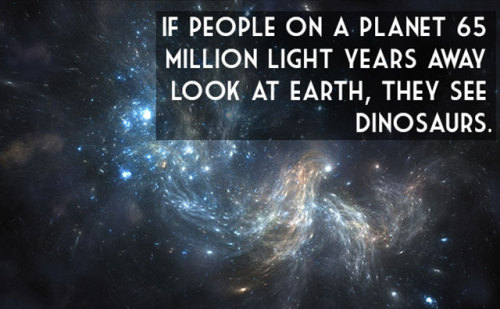
Thoughts that will change the way you think about the universe and your existence
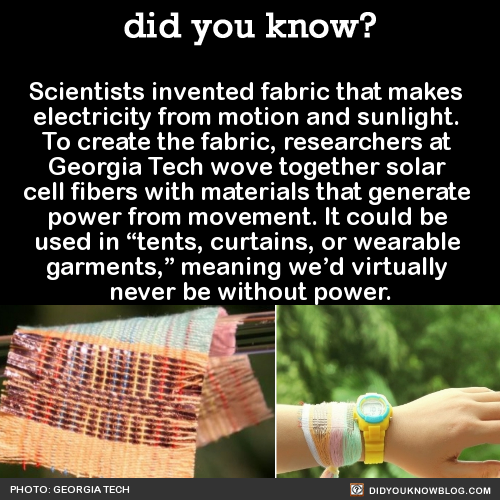
Scientists invented fabric that makes electricity from motion and sunlight. To create the fabric, researchers at Georgia Tech wove together solar cell fibers with materials that generate power from movement. It could be used in “tents, curtains, or wearable garments,” meaning we’d virtually never be without power. Source
-
 frjr9891 liked this · 6 months ago
frjr9891 liked this · 6 months ago -
 zetterstrom reblogged this · 8 years ago
zetterstrom reblogged this · 8 years ago -
 maevetheeuropan reblogged this · 8 years ago
maevetheeuropan reblogged this · 8 years ago -
 realestate7777-blog liked this · 8 years ago
realestate7777-blog liked this · 8 years ago -
 alphie-numeric liked this · 8 years ago
alphie-numeric liked this · 8 years ago -
 claraxbarton liked this · 8 years ago
claraxbarton liked this · 8 years ago -
 maevemauvaise reblogged this · 8 years ago
maevemauvaise reblogged this · 8 years ago -
 maevemauvaise liked this · 8 years ago
maevemauvaise liked this · 8 years ago -
 commiefornia reblogged this · 8 years ago
commiefornia reblogged this · 8 years ago -
 permasummer liked this · 8 years ago
permasummer liked this · 8 years ago -
 sugarsnob-blog liked this · 8 years ago
sugarsnob-blog liked this · 8 years ago -
 seventy-sdreamer reblogged this · 8 years ago
seventy-sdreamer reblogged this · 8 years ago -
 seventy-sdreamer liked this · 8 years ago
seventy-sdreamer liked this · 8 years ago -
 happythoughthall reblogged this · 8 years ago
happythoughthall reblogged this · 8 years ago -
 happythoughthall liked this · 8 years ago
happythoughthall liked this · 8 years ago -
 allofusdust reblogged this · 8 years ago
allofusdust reblogged this · 8 years ago -
 pphoto liked this · 8 years ago
pphoto liked this · 8 years ago -
 byungwookann liked this · 8 years ago
byungwookann liked this · 8 years ago -
 sollabecca liked this · 8 years ago
sollabecca liked this · 8 years ago -
 myowangs liked this · 8 years ago
myowangs liked this · 8 years ago -
 jakobmandel liked this · 8 years ago
jakobmandel liked this · 8 years ago -
 ahsah reblogged this · 8 years ago
ahsah reblogged this · 8 years ago







